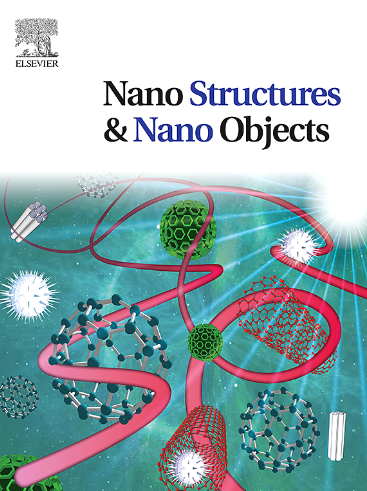冷浸谷草树皮提取物原位合成柔软、非聚集和分散良好的Ag0、Au0和Ag0包覆的Au0纳米颗粒:稳定性、dna结合和抗菌潜力
IF 5.45
Q1 Physics and Astronomy
引用次数: 0
摘要
自然资源衍生的纳米颗粒由于其在生物医学和其他领域的潜在应用而继续受到欢迎。本研究提出了一种原位合成方法,利用Combretum glutinosum茎皮组织的冷浸水提物合成软质、非聚集、分散良好的Ag.0、Au.0和Ag.0- coating - au。0纳米颗粒。CgAgNPs和CgAg0-Au0NPs的TEM和FESEM图像显示,CgAgNPs和CgAg0-Au0NPs具有柔软、非聚集、分散良好的球形颗粒,平均直径分别为13.10 nm和20.00 nm,而CgAuNPs的颗粒具有相同的特征,但具有不同的形状,包括球形、圆柱形、三角形、五边形和六边形,平均直径为29.48 nm。它们的平均水动力尺寸(DLS)、岩心尺寸(TEM)和晶体尺寸(PXRD)在4.0 ~ 45.5 nm之间,遵循了晶体尺寸小于岩心尺寸小于水动力尺寸的趋势。PXRD分析显示,CgAgNPs的平均晶径(nm)为4.49,CgAuNPs为9.23,CgAg0-Au0NPs为7.9。CgAg0-Au0NPs、CgAgNPs和CgAuNPs的zeta电位值表明,这些纳米颗粒具有很高的稳定性,而其带隙能的Tauc图的硬度(本文章由计算机程序翻译,如有差异,请以英文原文为准。
In-situ synthesis of soft, non-aggregated and well-dispersed Ag0, Au0 and Ag0-coated-Au0 nanoparticles using cold-macerated bark extract of Combretum glutinosum: Stability, DNA-binding, and antibacterial potential
Natural resource-derived nanoparticles have continued to gain popularity due to their potential application in the biomedical and other domains. This study presents an in-situ synthesis method that uses cold-macerated aqueous extract generated from Combretum glutinosum’s stem bark tissue to synthesize soft, non-aggregated, and well-dispersed Ag.0, Au.0, and Ag.0-coated-Au.0 nanoparticles. Their TEM and FESEM images demonstrated that they are soft, non-aggregated, well-dispersed, and spherically shaped particles with mean diameters of 13.10 nm and 20.00 nm for CgAgNPs and CgAg0-Au0NPs, respectively, whereas, particles of CgAuNPs exhibited the same characteristics but had variable shapes including spherical, cylindrical, triangular, pentagonal, and hexagonal with a mean diameter of 29.48 nm. Their mean hydrodynamic sizes (from DLS), core sizes (from TEM), and crystallite sizes (from PXRD) appeared in the range of 4.0–45.5 nm, which follows a trend of crystallite sizes ˂ core sized ˂ hydrodynamic sizes. Besides the crystallite sizes, PXRD analysis exposed their purity and crystallinity with average crystallite diameters (nm) of 4.49 for CgAgNPs, 9.23 for CgAuNPs, and 7.9 for CgAg0-Au0NPs. These nanoparticles are highly stable as revealed by their zeta potential values which were further supported by their hardness (դ) values obtained from the Tauc plot for the bandgap energies that followed a trend of դ= 2.495 (–29.5 mV) ˃ դ= 2.315 (–27.4 mV) ˃ դ= 1.495 (–13.2 mV) for CgAg0-Au0NPs, CgAgNPs, and CgAuNPs, respectively. The robust stability preserved their physicochemical behaviour over time and equipped them with promising biological effects. The binding potential of these nanoparticles to C.t.DNA revealed effective interaction with binding constant (Kb) values of 2.467 × 103 (CgAgNPs), 2.438 × 103 (CgAuNPs), and 2.199 × 103 (CgAg0-Au0NP), suggesting their usage as antimicrobial agents. Following this, they were investigated for antibacterial activities and the outcomes unveiled strong activity with potent IC50 of 0.05 mg/ml(50 µg./ml) over Staphylococcus aureus and 0.1 mg/ml(100 µg/ml) over Pseudomonas aeruginosa for CgAgNPs; 0.1 mg/ml(100 µg/ml) over both organisms for CgAuNPs; and 0.05 mg/ml(50 µg/ml) over both organisms for CgAg0-Au0NPs. Their stability, softness, non-aggregation, and well-dispersed nature equipped them with incredible biological effects which are credited to the synergistic potential contributed by each component.
求助全文
通过发布文献求助,成功后即可免费获取论文全文。
去求助
来源期刊

Nano-Structures & Nano-Objects
Physics and Astronomy-Condensed Matter Physics
CiteScore
9.20
自引率
0.00%
发文量
60
审稿时长
22 days
期刊介绍:
Nano-Structures & Nano-Objects is a new journal devoted to all aspects of the synthesis and the properties of this new flourishing domain. The journal is devoted to novel architectures at the nano-level with an emphasis on new synthesis and characterization methods. The journal is focused on the objects rather than on their applications. However, the research for new applications of original nano-structures & nano-objects in various fields such as nano-electronics, energy conversion, catalysis, drug delivery and nano-medicine is also welcome. The scope of Nano-Structures & Nano-Objects involves: -Metal and alloy nanoparticles with complex nanostructures such as shape control, core-shell and dumbells -Oxide nanoparticles and nanostructures, with complex oxide/metal, oxide/surface and oxide /organic interfaces -Inorganic semi-conducting nanoparticles (quantum dots) with an emphasis on new phases, structures, shapes and complexity -Nanostructures involving molecular inorganic species such as nanoparticles of coordination compounds, molecular magnets, spin transition nanoparticles etc. or organic nano-objects, in particular for molecular electronics -Nanostructured materials such as nano-MOFs and nano-zeolites -Hetero-junctions between molecules and nano-objects, between different nano-objects & nanostructures or between nano-objects & nanostructures and surfaces -Methods of characterization specific of the nano size or adapted for the nano size such as X-ray and neutron scattering, light scattering, NMR, Raman, Plasmonics, near field microscopies, various TEM and SEM techniques, magnetic studies, etc .
 求助内容:
求助内容: 应助结果提醒方式:
应助结果提醒方式:


